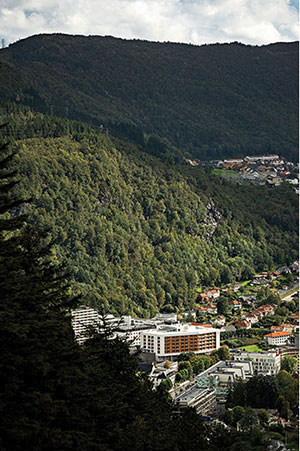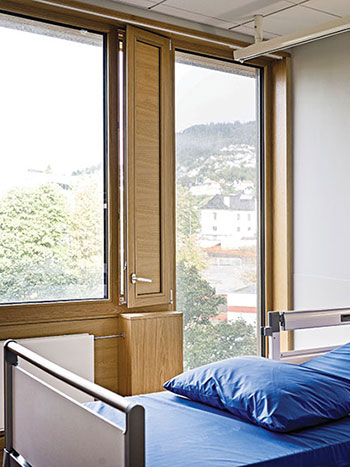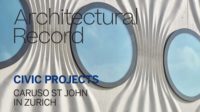Innovative hospital buildings don’t necessarily appear to be so from the outside. Often, it’s the fine-tuning of the internal organization that can appreciably improve health care. The new oak-clad patient building at Haraldsplass hospital is nestled nicely into the foot of the heavily wooded Ulriken Mountain, the highest of the celebrated seven mountains that surround the city center of Bergen, Norway’s second-largest city. The gently angled outward-facing facade follows the course of the Møllendalselven River beneath it.
Additional Content:
Jump to credits & specifications
If the site sounds idyllic, it is. The latest hospital building is one of eight erected here on former farmland. The first, designed by prominent local Modernist architect Per Grieg, was opened in 1940 by the sisters of the Deaconess Foundation, a Christian organization that continues to operate the much expanded facility. Though most hospitals in Norway are public, funded and owned by the state, Haraldsplass is among a small number of privately run hospitals. Yet it is situated near several public hospital complexes that together form a large, integrated regional medical center accessible to all.

Haraldsplass’s new building was designed by the Oslo office of Danish architecture firm C.F. Møller, which won a 2011 competition for the project and has a large health-care portfolio throughout Scandinavia and northern Europe. The structure mainly contains 170 beds for general care and to support surgical units in other buildings, but also includes a small hospice on the ground floor with access to a garden, as well as one of Norway’s largest emergency centers. The straightforward building, which is positioned in front of the older structures and a 200-year-old allée of trees, offers a new entrance to the complex on its river-facing west facade. Its partially wood-clad exterior distinguishes itself for the most part from the rational white facades of those modest existing buildings. Inside, however, things are radically different.
The kink in the river-facing facade occurs midway through the building and helps shape two large interior atria—one trapezoidal, the other more rectangular. The atria, with their glazed roofs, not only flood the interiors with daylight but create unique circulation loops that free this structure of the endless corridors plaguing so many hospitals, and provide efficient logistics, flexibility, and proximity between caregivers and patients.
Haraldsplass recognized the need for a new building to modernize patient care for the country’s aging population. (Birth rates in Norway have dropped to historic lows in the last few years.) The older buildings featured low ceilings, outdated infrastructure, small bathrooms, and multi-bed patient rooms. (One such building, from 1970, has been transformed into an outpatient facility.)
The novel layout allows the digitized care—each nurse is equipped with an iPhone 7 to access patient files and track lab results—to be organized around four nursing clusters per floor, anchored by custom-designed Corian workstations beside an enclosed workspace for two to three nurses.
A typical floor features approximately 30 patient rooms, the vast majority of which are single-bed units, including four isolation units. (While more costly, according to Haraldsplass program director Kim Sperstad, private rooms are clearly more desirable, and are said to help reduce the spread of infection.) They are situated along the exterior perimeter of the building with access to daylight and views, while support spaces like offices, medicine dispensaries, and storage surround the atria. Every floor—each with a different color scheme—has a multifunctional room that alternately serves as an office or therapy room, in addition to exam and meeting rooms.

The patient rooms were designed to feel domestic, with wood accents and wood-finished vinyl floors. Soundproofing in the doors, ceilings, floors, and facades, including two layers of gypsum in the interior walls, keep the rooms, with their views of nature, quiet and serene. Each bathroom, known as the “Bergen Bath,” includes automated sinks and toilets developed between local architects and manufacturers, that raise and lower at the touch of a button.
The grand space of the multistory atrium is immediately apparent upon arriving through the building’s west side. While the patient rooms provide tranquil private space, the atria, clad in striking oak slats backed by acoustic insulation, offer similarly relaxing social space. The atrium at the main entrance includes reception and an independently run café, while the other, less busy one features balcony nooks for individual or group seating. A piano in each atrium is occasionally put to spirited use by the doctors’ choir, and sometimes patients, visitors, or staff.
The new structure was built on what had been a parking area (which has since been moved to a facility built into the mountain.) A new footbridge across the Møllendalselven brings visitors to a light rail stop under construction that will soon supplement the current bus route to the city center. Another bridge between the new structure and an earlier one connects hospital buildings while maintaining the cherished allée of trees. C.F. Møller addressed sustainability concerns in several ways, including the use of natural, recyclable, and maintenance- free materials. The highly insulated roof and facades—in addition to oak, they are clad in white fiber concrete panels—satisfy Passive House standards.
Because Bergen is surrounded by mountains and the spectacular fjords along Norway’s western coast, its oceanic climate experiences excessive precipitation and plenty of overcast days, giving it a reputation for being one of the world’s rainiest cities. A recent visit to the hospital coincided with a rare sunny day, which had the unfortunate side effect, especially for bedridden patients, of the shades’ lowering automatically on all but the north facade—another sustainability measure, one that patients can’t override. The almost opaque shades obscured those much-desired views of nature for a good part of the afternoon. But at least, on those infrequent occasions, the sunny and lively courtyards provide solace. And on no occasion does Haraldsplass feel like a typical hospital—either for visitors or, more importantly, for patients.
CreditsArchitect: C.F. Møller Architects — Christian Dahle, Lone Wiggers, partners in charge; Reidunn Jarrett, Anne Underhaug, Florian Wagnerberger, project architects; Paul Holt‑Seeland, facade design
Engineering: Rambøll (civil), Sweco (fire protection)
Consultants: Asplan Viak (landscape) Rambøll (acoustics and lighting) Erstad & Lekven (project management)
General contractor: LAB Entreprenør
Size: 153,000 square feet
Cost: $55 million (construction)
Completion date: October 2018
|
SpecificationsGlazing Kebo Glass
Wood frame Viking Window
Fiber concrete cladding BB Fiberbeton
Elevators Thyssenkrupp
Roofing Fløysand Tak
Waterproofing Protan
Sliding doors Metaflex Medicare
Lighting Fagerhult, Limelight
Bathrooms Bano |













Post a comment to this article
Report Abusive Comment